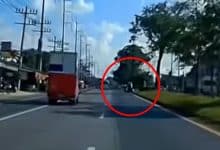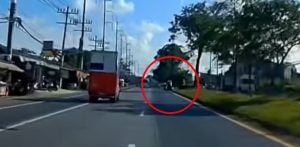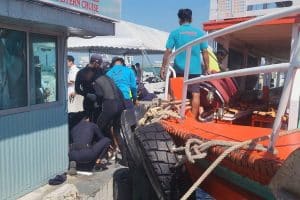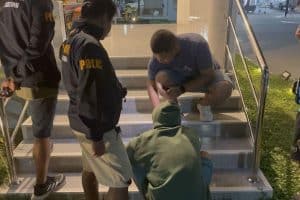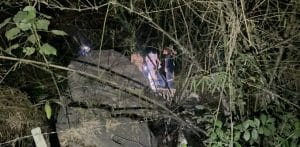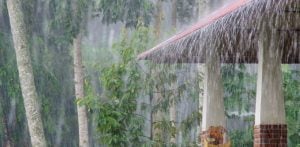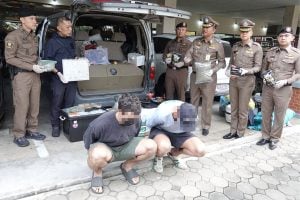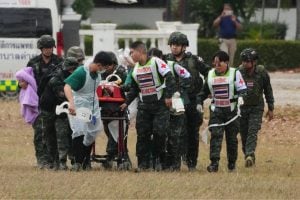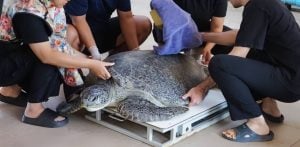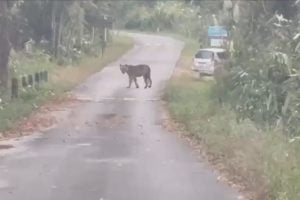Tsunami warning system improvements stalled

PHUKET: Plans for Thailand to launch two more “tsunameters” off the Andaman coastline to improve its tsunami warning system capability have become bogged down by red tape and technical problems, leaving only one direct detection unit in place as the fourth anniversary of the 2004 disaster nears.
Dr Smith Dharmasaroja, who chairs the committee that directs the Nonthaburi-based National Disaster Warning Center (NDWC), last weekend told the Gazette that the NDWC was budgeted 165 million baht for the two tsunami direct detection units in 2007.
When deployed about 250 to 300 kilometers off Phuket, they will greatly enhance the NDWC’s ability to detect and warn of an impending tsunami, he said.
Technically known as Deep-ocean Assessment and Reporting of Tsunami (Dart) monitoring systems, the state-of-the-art tsunameters consist of a pressure sensor on the ocean floor that relays data to a surface buoy equipped with satellite technology.
The units enable national agencies, such as the NDWC, to detect a tsunami and issue a warning in real time. They also eliminate the need for expensive, panic-inducing false alarms that can occur when warnings are issued based on seismic data alone.
Unfortunately, the contractor the NDWC is negotiating with to provide the two tsunameters is unable to meet the technical requirements that Thailand and India agreed to in their effort to set up a regional system, Dr Smith said.
Describing himself as “only an employee”, Dr Smith said the authority to move forward with the purchase rests with the ICT Ministry and its Meteorology Department, which must first approve all technical aspects and sign off on procurement.
Two “tsunameters” have been deployed in the Indian Ocean since the tsunami. The first, launched by Thailand and the US on December 1, 2006, in the middle of the Indian Ocean, is still functioning normally and providing date to the NDWC.
Last year Dr Smith confirmed the suspicions of a Gazette reporter that the location of the first tsunameter was too far west of the subduction zone where the last tsunami originated to be of real benefit to Phuket should another tsunami-producing earthquake occur there, because by the time the west-moving tsunami wave reaches the sensor, its east-moving counterpart would already have reached Phuket beaches.
However, Dr Smith described as inaccurate reports attributed to Dr Plodprasop Surasawadee who, as assistant minister of the Prime Minister’s Office, was quoted by a Bangkok-based English-language daily in May as saying that the first Thai tsunameter was not working at all.
Jakarta-based David McKinnie, of the US National Oceanic and Atmospheric Administration (NOAA) serving as a coordinator for the Indian Ocean Tsunami Warning System (IOTWS), also confirmed that the Thai tsunameter is still functioning normally.
“It is operating and providing full services to Thailand as well as other Indian Ocean nations,” he wrote the Gazette in an email. He encouraged readers to confirm this by visiting the website www.ndbc.noaa.gov/dart.shtml that displays monitoring data from the Thai station and many others from its global network.
He agreed, however, that the Dart unit needs better maintenance.”Under our agreement with Thailand, NDWC was to establish a maintenance contract for the system by December 2006. These systems need regular maintenance and the Thai station is long overdue for such routine work. We are concerned that no agreement is in place, though we understand NDWC and the Thai Meteorological Department are making progress in this area,” he wrote.
The second tsunameter, further south off the coast of Sumatra, is broken, he admitted.
“The second tsunameter deployed in partnership with Indonesia in September, 2007, was providing data to NDWC until it was vandalized by fishermen in March, 2008. We are working with Indonesian authorities to redeploy a tsunameter there as soon as possible,” he said.
“We know that NDWC is planning to purchase two additional tsunameters as well and that NDWC has issued a solicitation for procurement. Although we are aware of other elements of the Thai system, I do not have good information about NDWC plans for developing the Thai tsunami warning system or progress toward NDWC goals in this area,” he said.
Mr McKinnie also refutes claims that the location where the first Thai-US Dart unit was deployed was poorly chosen. In fact the siting is nearly optimal, he said.
“One of the basic siting considerations is that tsunami waves travel very fast in deep water and much more slowly in shallow water. The waters between Phuket and the Andamans are relatively shallow. The water from the source to the Dart station is relatively deep. A tsunami would reach the Dart station 1.5 to two hours before it would reach Phuket, thus the station provides a potential warning lead time of 1.5 to two hours. A tsunameter sited closer to Phuket would provide less, not more, lead time,” he wrote.
In a related development, Dr Smith confirmed that he is very worried about the possibility of a disaster in low-lying coastal parts of Bangkok and Samut Prakarn provinces should a storm similar to Cyclone Nargis, which devastated Burma’s Irrawaddy Delta region, make landfall and cause a storm surge there.
If such a tragedy did occur it would most likely happen between August and November, he said.
“It’s my duty to warn people of the danger. Whether or not they choose to believe me is up to their own judgment,” said Dr Smith.
As a former director of the Meteorological Department, Dr Smith lobbied the government of the time, in vain, to address the dangers of a tsunami years before the 2004 disaster.
Latest Thailand News
Follow The Thaiger on Google News:

